What Percentage Of People Are Registered Independent
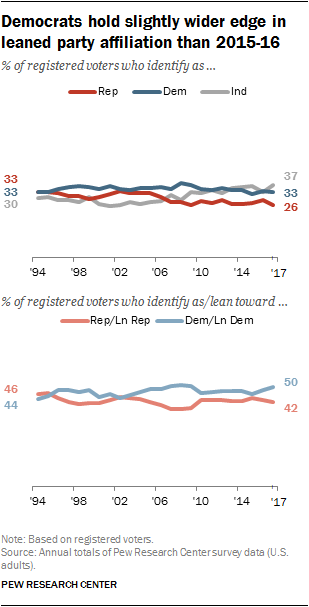 The balance of partisan affiliation – and the combined measure of partisan identification and leaning – has not changed substantially over the past 2 decades. However, Democrats hold a slightly larger edge in leaned party identification over Republicans now than in 2016 or 2015.
The balance of partisan affiliation – and the combined measure of partisan identification and leaning – has not changed substantially over the past 2 decades. However, Democrats hold a slightly larger edge in leaned party identification over Republicans now than in 2016 or 2015.
In Pew Research Center surveys conducted in 2017, 37% of registered voters identified as independents, 33% every bit Democrats and 26% as Republicans. When the partisan leanings of independents are taken into account, 50% either identify as Democrats or lean Democratic; 42% identify as Republicans or lean Republican.
The 8-per centum-point Democratic advantage in leaned partisan identification is wider than at any betoken since 2009, and a statistically significant shift since 2016, when Democrats had a 4-indicate border (48% to 44%). The analysis in this written report draws on more than 10,000 interviews with registered voters in 2017 and tens of thousands of interviews conducted in previous years (see Methodology for additional particular).
In that location continue to be fundamental differences in the partisan orientation of dissimilar demographic groups, and in many cases these gaps have grown wider in recent years. For instance, gender, generational, geographic and educational divides are now as broad, or wider, than in Pew Inquiry Heart surveys going dorsum more than two decades.
Wide gender gap in partisanship
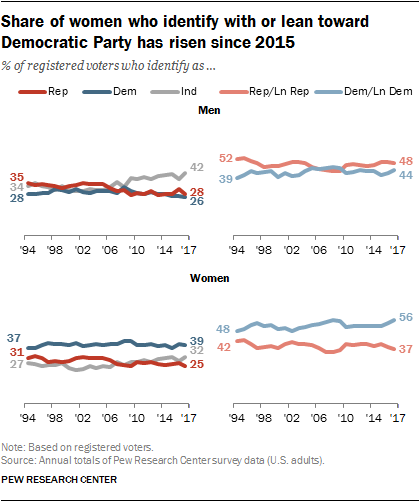 As has been the case for more than two decades of Pew Research Heart surveys, women are significantly more probable than men to acquaintance with the Democratic Party. While the gender gap has changed footling in recent years, it is every bit broad every bit it has been at any point during this period: Among registered voters, 56% of women affiliate with or lean toward the Democratic Party, compared with 44% of men.
As has been the case for more than two decades of Pew Research Heart surveys, women are significantly more probable than men to acquaintance with the Democratic Party. While the gender gap has changed footling in recent years, it is every bit broad every bit it has been at any point during this period: Among registered voters, 56% of women affiliate with or lean toward the Democratic Party, compared with 44% of men.
From 2010 through 2015, nearly half of women (51%-52%) identified with or leaned toward the Democratic Political party. Just the share of women who place with or lean to the Autonomous Party has risen in recent years, to 54% in 2016 and 56% in 2017. The partisan breakup of men is relatively unchanged over this period.
The Democratic gains among women accept not come from increased affiliation with the party. Overall, the proportion of women voters who place with (rather than lean toward) the Democratic Party has remained relatively constant for the by 25 years (in 1994, 37% of women said they identified with the Democratic Political party, compared with 39% in 2017).
Black, Hispanic and Asian voters remain overwhelmingly Democratic
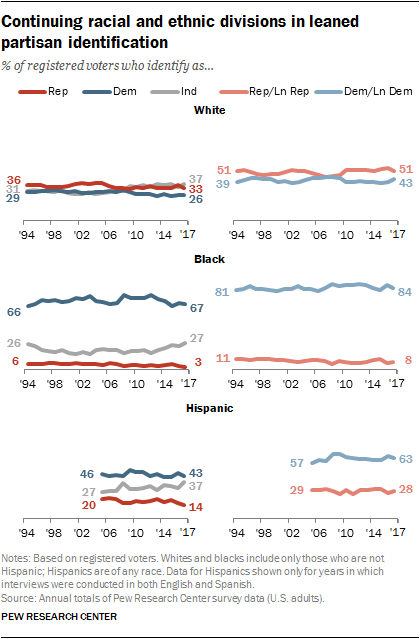 There are sizable and long-standing racial and ethnic differences in partisan affiliation, and they take shifted only modestly in recent years.
There are sizable and long-standing racial and ethnic differences in partisan affiliation, and they take shifted only modestly in recent years.
White voters continue to be somewhat more than likely to affiliate with or lean toward the Republican Party than the Democratic Political party (51% to 43%).
Since 2010, white voters have been more likely to align with the GOP than with the Democrats. However, the share of whites identifying equally Democrats or leaning Democratic has edged upward (43% now, up from no more 40% from 2009 to 2016). This growth is attributable to a slight increase in Democratic-leaning independents, rather than a rise in Autonomous affiliation.
By contrast, African American voters remain overwhelmingly Democratic: 84% identify with or lean toward the Democratic Party. Just 8% of black voters identify in some way with the Republican Party.
While blackness voters remain solidly Autonomous, identification with the Democratic Party has declined modestly in recent years: About two-thirds of African Americans have identified as Democrats in the final several years, down slightly from the get-go half of Barack Obama'southward presidency, when about three-quarters affiliated with the Democratic Party.
By more than 2-to-one (63% to 28%), Hispanic voters are more likely to affiliate with or lean toward the Democratic Party than the GOP. The overall residuum of partisan orientation among Hispanics is little changed over the last decade.
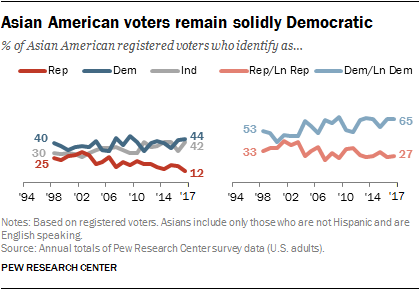
At that place is a similar balance of partisanship among Asian American registered voters: 65% identify with the Democratic Political party or lean Democratic, compared with 27% who place as or lean Republican.
In 1998 (the commencement yr for which sample sizes of Asian American voters were sufficiently big plenty in Pew Research Center surveys), 53% of Asians identified with or leaned toward the Autonomous Party and 33% identified with or leaned toward the Republican Party. (Note: Only English-speaking Asian American voters are included in the data).
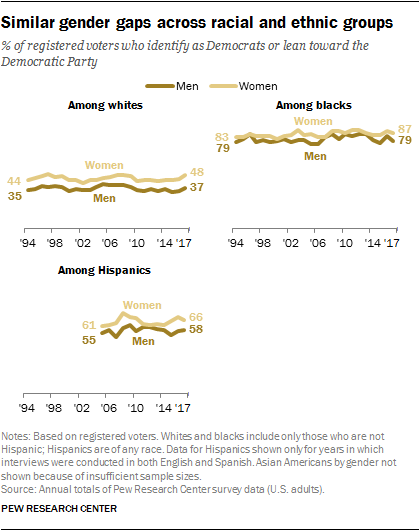
The share of Asian American voters who identify every bit Republican is at present simply 12%. While this is little changed in the final few years, it represents the continuation of a longer trend in failing Republican affiliation among Asian voters. Among Asians, identification with the Democratic Political party has remained relatively stable over this period. The share of Asian voters who say they are political independents has risen steadily since 1998, reflecting a more general trend among all voters.
A gender gap in partisan amalgamation and leaning is seen across racial and ethnic groups.
For instance, in that location is a 9-percentage-point gender gap among white voters: While 48% of white women affiliate with or lean toward the Democratic Political party, 37% of white men do so. Similarly, there is an 8-point gender gap amidst blackness voters (87% of blackness women vs. 79% of black men), as well as among Hispanic voters (66% of women vs. 58% of men).
Educational gap in partisan orientation continues to grow
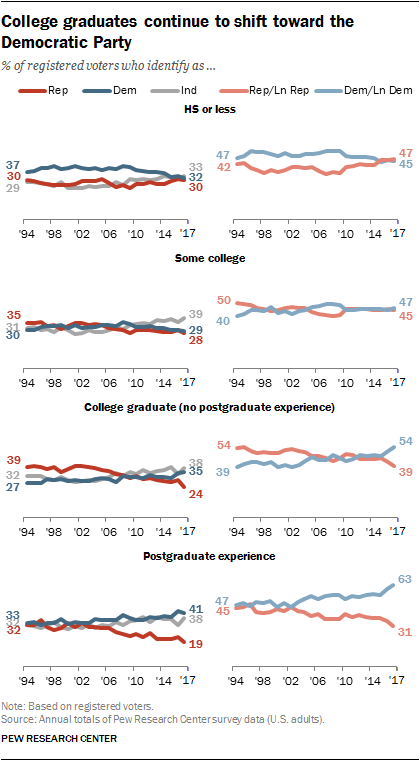 Higher educational attainment is increasingly associated with Autonomous Party affiliation and leaning. At the aforementioned time, those without college experience – in one case a group that tilted more than Autonomous than Republican – are roughly divided in their partisan orientation.
Higher educational attainment is increasingly associated with Autonomous Party affiliation and leaning. At the aforementioned time, those without college experience – in one case a group that tilted more than Autonomous than Republican – are roughly divided in their partisan orientation.
These twin shifts have resulted in the widest educational gap in partisan identification and leaning seen at any point in more than two decades of Pew Research Heart surveys.
In 1994, 39% of those with a four-yr higher caste (no postgraduate feel) identified with or leaned toward the Democratic Party and 54% associated with the Republican Party. In 2017, those figures were exactly reversed.
Democratic gains have been even more pronounced amongst those who pursue postgraduate educational activity. In 1994, those with at least some postgraduate experience were evenly split up between the Autonomous and Republican parties. Today, the Democratic Party enjoys a roughly two-to-one advantage in leaned partisan identification. While some of this shift took place a decade ago, postgraduate voters' amalgamation with and leaning to the Democratic Party take grown substantially but over the by few years, from 55% in 2015 to 63% in 2017.
By contrast, Republicans have been gaining ground over the past several years with those who do not have bachelor'southward degrees. Among those with no more than a high school education, 47% affiliate with the GOP or lean Republican, while 45% identify every bit Democrats or lean Democratic. Democrats held a pregnant advantage amidst voters with a loftier school degree or less education for much of the belatedly 1990s through early 2000s, and as recently as 2014 (47% Democratic, 42% Republican).
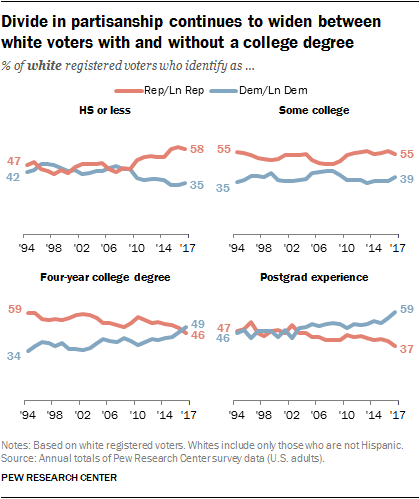 These overall patterns in teaching and partisanship are particularly pronounced among white voters. While the GOP has held meaning advantages over the Democratic Party among white college graduates without postgraduate feel over much of the past two decades, these voters are divided in their partisanship today.
These overall patterns in teaching and partisanship are particularly pronounced among white voters. While the GOP has held meaning advantages over the Democratic Party among white college graduates without postgraduate feel over much of the past two decades, these voters are divided in their partisanship today.
In 2017, 49% of white voters with a higher caste (and no additional education) aligned with the Democratic Party, compared with 46% for the GOP. As recently as 2015, 51% of white voters with a college degree aligned with the Republican Party, compared with 43% for the Autonomous Party.
And among voters with postgraduate experience, the Democratic advantage has grown. In 2017, 59% of white voters with at to the lowest degree some additional education beyond a four-year caste identified as Democrats or leaned Democratic, while 37% identified with or leaned toward the Republican Party; as recently as 2015 that balance was slightly narrower (52% to 41%).
By contrast, white voters with no more a high schoolhouse education accept moved more to the GOP over the final 10 years, though there has been little change since 2015. As recently as 2009, these voters were divided in leaned partisanship. Since and then, Republicans have held significant advantages, including a 23-percentage-point pb in 2017 (58% Republican, 35% Democratic).
A wide – and growing – generational separate in partisanship
 The generational gap in partisanship is at present more pronounced than in the past, and this echoes the widening generational gaps seen in many political values and preferences.
The generational gap in partisanship is at present more pronounced than in the past, and this echoes the widening generational gaps seen in many political values and preferences.
Millennial voters (built-in 1981 to 1996) accept had a Democratic tilt since they first entered adulthood; this advantage has just grown equally they have aged.
Democrats enjoy a 27-percentage-point advantage amid Millennial voters (59% are Democrats or lean Democratic, 32% are Republican or lean Republican). In 2014, 53% of Millennial voters were Democrats or leaned Democratic, 37% tilted toward the GOP.
Millennials remain more probable than those in older generations to call themselves independents (44% vs. 39% of Gen Xers, 32% of Boomers and 27% of Silents); still, the roughly ii-to-one Democratic reward amidst Millennials is credible both in "straight" and "leaned" partisan affiliation.
Generation X voters (born 1965 to 1980) are more divided in their partisan attachments, but also tilt toward the Autonomous Political party (48% identify as or lean Democratic, 43% place as or lean Republican). The rest of leaned partisan identification among Gen 10 voters has been relatively consistent over the past several years. Baby Boomer voters (born 1946 to 1964) are nearly evenly divided (48% identify as or lean Democratic, 46% Republican).
The Silent Generation (born 1928 to 1945) is the only generational grouping that has more GOP leaners and identifying voters than Democratic-oriented voters. About half (52%) of Silent Generation voters identify with or lean toward the Republican Political party, a larger share than a decade ago; 43% identify with or lean toward the Democratic Party.
 While there is a gender gap in partisan affiliation within every generational accomplice, it is peculiarly pronounced amid Millennial voters. A big majority of Millennial women (seventy%) place with or lean toward the Democratic Party, compared with 49% of Millennial men.
While there is a gender gap in partisan affiliation within every generational accomplice, it is peculiarly pronounced amid Millennial voters. A big majority of Millennial women (seventy%) place with or lean toward the Democratic Party, compared with 49% of Millennial men.
This wide gender gap among Millennial voters is largely attributable to a marked shift amid Millennial women. As recently as 2014, the Democratic advantage amid Millennial women was a narrower – merely all the same substantial – 21 percentage points, compared with 47 points today. The residual of partisanship among Millennial men was similar in 2014 as information technology is today (50% Democratic vs. xl% Republican).
 Gender gaps in other generations are more modest. For instance, 57% of Silent Generation men identify with or lean toward the GOP, compared with 48% of Silent women.
Gender gaps in other generations are more modest. For instance, 57% of Silent Generation men identify with or lean toward the GOP, compared with 48% of Silent women.
Across all generations, nonwhite voters are overwhelmingly Democratic in their leanings, while whites are more than divided. Among white voters, Millennials are the simply generation in which the share of Democrats and Democratic leaners (52%) is greater than the share of Republicans and Republican leaners (41%).
Among older generations of whites – simply particularly amidst white Silents – more voters marshal with the GOP than the Autonomous Party.
White Silent Generation voters have moved toward the GOP in contempo years. Today, 59% identify with or lean to the GOP, upwards from 43% a decade ago.
White Gen Xer and Boomer voters accept remained relatively stable in their partisan makeup in contempo years. In both generations, the GOP enjoys a similar minor advantage (xi percent points amid white Gen Xers, 12 points amid white Boomers); these are similar to the balances in 2014.
Religious affiliation and political party identification
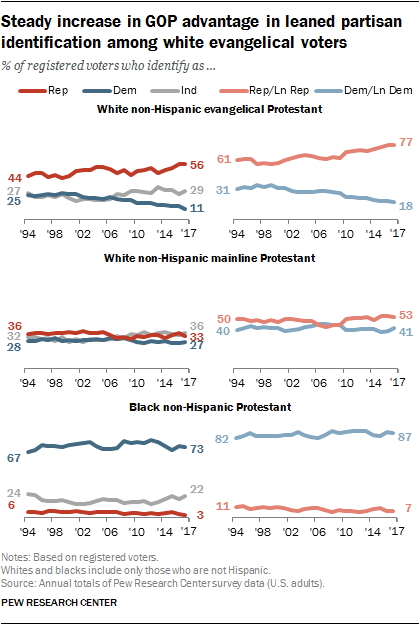 White evangelical Protestants remain one of the well-nigh reliably Republican groups of voters, and the GOP's advantage among this segment of the population has continued to abound in recent years: 77% of white evangelical voters lean toward or identify with the Republican Party, while just 18% have a Democratic orientation.
White evangelical Protestants remain one of the well-nigh reliably Republican groups of voters, and the GOP's advantage among this segment of the population has continued to abound in recent years: 77% of white evangelical voters lean toward or identify with the Republican Party, while just 18% have a Democratic orientation.
White mainline Protestant voters are more divided in their political identities. As has been the instance for the concluding several years, a narrow majority (53%) affiliates with or leans to the GOP, while 41% lean toward or identify with the Democratic Party.
Black Protestant voters remain solidly Democratic in their partisan loyalties. Nearly 9-in-ten (87%) lean toward or place with the Autonomous Political party.
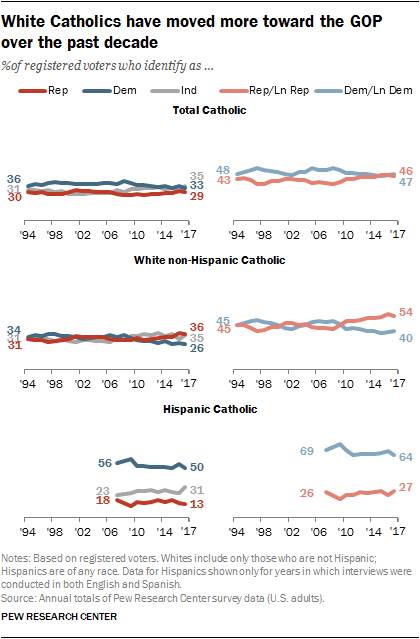 Overall, Catholic voters are roughly evenly carve up betwixt the share who identify with or lean to the Republican (46%) and Democratic (47%) parties. But white Catholics and Hispanic Catholics diverge politically.
Overall, Catholic voters are roughly evenly carve up betwixt the share who identify with or lean to the Republican (46%) and Democratic (47%) parties. But white Catholics and Hispanic Catholics diverge politically.
White Catholic voters now are more Republican (54%) than Democratic (40%). While the partisan balance among white Catholic voters is little changed in recent years, this grouping was more evenly divided in their partisan loyalties about a decade agone.
Hispanic Catholics, who correspond a growing share of the Catholic population in the U.S., are substantially more Democratic in their orientation (64% of Hispanic Catholic voters affiliate with or lean to the Democratic Party, 27% to the GOP).
 While Mormon voters remain a solidly Republican grouping (72% overall are Republican or Republican leaning), in recent years Mormons accept been less likely to identify every bit Republican than in the by.
While Mormon voters remain a solidly Republican grouping (72% overall are Republican or Republican leaning), in recent years Mormons accept been less likely to identify every bit Republican than in the by.
Mormon voters are now near equally probable to place as independent (41%) as they are to identify as Republican (45%). For well-nigh of the by two decades, majorities of Mormons called themselves Republicans.
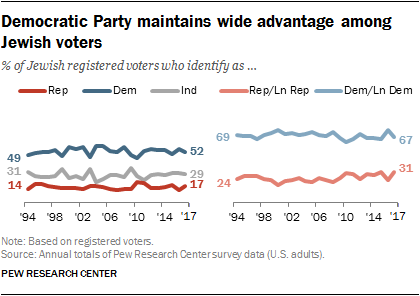 By well-nigh 2-to-i, Jewish voters proceed to identify with or lean toward Democratic Party (67% vs. 31% who identify with or lean Republican). This balance is little inverse over the concluding decade.
By well-nigh 2-to-i, Jewish voters proceed to identify with or lean toward Democratic Party (67% vs. 31% who identify with or lean Republican). This balance is little inverse over the concluding decade.
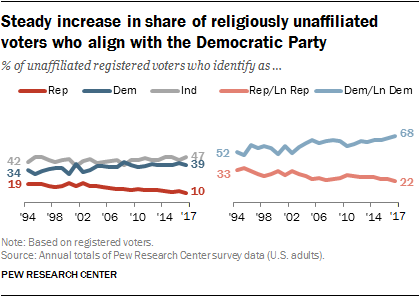 The religiously unaffiliated, a growing share of the population, take shown steady movement in orientation toward the Democratic Party. In 1994, near half (52%) of religiously unaffiliated voters leaned toward or identified with the Autonomous Party. Today nearly seven-in-10 (68%) practise then.
The religiously unaffiliated, a growing share of the population, take shown steady movement in orientation toward the Democratic Party. In 1994, near half (52%) of religiously unaffiliated voters leaned toward or identified with the Autonomous Party. Today nearly seven-in-10 (68%) practise then.
Urban voters grow more Democratic, rural voters more than Republican
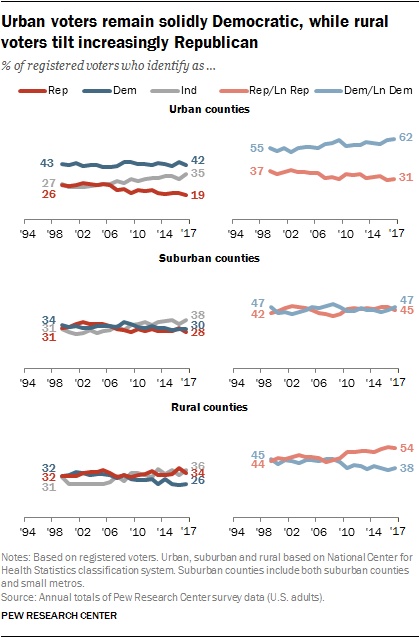 Voters in urban counties have long aligned more with the Democratic Party than the Republican Political party, and this Autonomous advantage has grown over time. Today, twice equally many urban voters identify as Democrats or lean Democratic (62%) as chapter with the GOP or lean Republican.
Voters in urban counties have long aligned more with the Democratic Party than the Republican Political party, and this Autonomous advantage has grown over time. Today, twice equally many urban voters identify as Democrats or lean Democratic (62%) as chapter with the GOP or lean Republican.
Overall, those who alive in suburban counties are most evenly divided in their partisan loyalties (47% Democratic, 45% Republican), little inverse over the last two decades.
Voters in rural areas accept moved in a more Republican direction over the terminal several years. From 1999 to 2009, rural voters were about as divided in their partisan leanings. Today, there is a sixteen-percentage-point advantage for the GOP among rural voters.
While at that place are racial and ethnic differences in the makeup of rural, suburban and urban areas, this overall pattern of geographic divergence is also seen among whites. Among rural whites, the GOP enjoyed a roughly 10-percentage-betoken advantage throughout much of the 2000s; the GOP reward among rural white voters is at present 24 percentage points (58% to 34%). At the same time, while urban white voters were roughly evenly divided in their political preferences for much of the concluding ii decades, in recent years the Autonomous Political party has enjoyed a double-digit partisan advantage: Today, 54% of white urban voters are Democrats or lean Autonomous, while 41% identify with the GOP or lean Republican.
What Percentage Of People Are Registered Independent,
Source: https://www.pewresearch.org/politics/2018/03/20/1-trends-in-party-affiliation-among-demographic-groups/
Posted by: faulkhaden1945.blogspot.com


0 Response to "What Percentage Of People Are Registered Independent"
Post a Comment